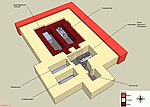Psusennes I.
| Name of Psusennes I. | ||||||||||||||||||||||||||
|---|---|---|---|---|---|---|---|---|---|---|---|---|---|---|---|---|---|---|---|---|---|---|---|---|---|---|

Gold mask Psusennes I ( Egyptian Museum Cairo , JE 85913)
|
||||||||||||||||||||||||||
| Horus name |
K3-nḫt-m-dd-Jmn (wsr-f3w sḫˁj-m-W3st) Strong bull, in the arms of Amun (, rich in power that shines in Thebes ) |
|||||||||||||||||||||||||
| Sideline |
Wr-mnw-m-Jpt-swt nb-pḥtj wˁf-t3wj w3ḥ-nsyt-mj-Rˁ-m -pt Large in monuments in Karnak , mighty lord, royal protector of the two countries, like Re , the lord of heaven |
|||||||||||||||||||||||||
| Gold name |
Sm3-ḫprw dr-pḏt-9 jṯj-m-sḫm = f-t3w-nbw Who unites the figures, who unites the nine bows (the enemies Egypt), who in his strength conquered all countries. |
|||||||||||||||||||||||||
| Throne name |
ˁ3-ḫpr-Rˁ-stp.n-Jmn With great stature , a Re, chosen by Amun |
|||||||||||||||||||||||||
| Proper name |
P3-sb3-ḫˁj-n-njwt-mrj-Jmn The star who appeared in the city, beloved of Amun |
|||||||||||||||||||||||||
Psusennes I (ancient Egyptian: Pasebachaenniut) was the 3rd ancient Egyptian king ( Pharaoh ) of the 21st Dynasty ( Third Intermediate Period ) and ruled from around 1040 to around 994 BC. BC He was the successor of Amenemnesut .
Origin and family
He is possibly the son of Pinudjem I and the Henuttaui. His sister wife is Mutnedjmet . Other siblings include the wife of God of Amun Maatkare and the high priests of Amun Masaharta and Mencheperre . Mencheperre's wife, Isetemachbit, came from a co-consort named Wiai.
Both a variant of his name "Ramses-Psusennes" and a son who is known by name, Ramses-Anchefenmut, who was the king's general , suggest a relationship to the 20th dynasty . Karl Jansen-Winkeln sees no evidence of this. Another son with Mutnedjmet was his successor Amenemope .
Domination
Since nothing is known about foreign policy activities, it can be assumed that his policy was only set to secure his national borders. High dignitaries are the general and head of the priests of all gods Wendjebauendjed , the head of the chamberlain Nesienamun and his son Anchefenamun. Amenemope is believed to have been his co-regent for the last three years in office.
Construction activities
In Tanis , Psusennes I stood out particularly through his building activities. He not only expanded the city into the capital, but also had temples built for the gods Amun , Mut and Chons , which were located within a large, approx. 20 m thick wall. Among other things, a foundation stone has been preserved from the Great Amun Temple. Baboon statues were found in the area of the later Chon temple, other fragments in the south temple.
His grave
The pristine grave of Psusennes I was found in 1940 by Pierre Montet as grave no. 3 in Tanis. The king's mummy and that of his wife Mutnedjmet were in the tomb . Prince Anchefenmut was buried in a side chamber and the general and head of the priests of all gods Wendjebauendjed in the antechamber. Subsequently, Pharaoh Amenemope was buried in the chamber intended for Mutnedjmet and Pharaoh Scheschonq II. In the antechamber .
The outer sarcophagus made of rose granite was taken over from Merenptah (19th Dynasty, New Kingdom ) and probably comes from his grave KV8 in the Valley of the Kings . It enclosed a second sarcophagus made of black granite , which in turn was a reused private sarcophagus, also from the New Kingdom, and this contained a coffin made of solid silver, decorated with gold . The latter was obviously actually made for Psusennes I. The most important piece of grave equipment was the gold mask. His mummy, richly decorated with jewelry, had completely crumbled when the grave was opened.
literature
- Karl Jansen-Winkeln : Relative Chronology of Dyn. 21. In: Erik Hornung , Rolf Krauss , David A. Warburton (Eds.): Ancient Egyptian Chronology (= Handbook of Oriental studies. Section One. The Near and Middle East. Volume 83 ). Brill, Leiden / Boston 2006, ISBN 978-90-04-11385-5 , pp. 218-233 ( online ).
- Thomas Schneider : Lexicon of the Pharaohs. Albatros, Düsseldorf 2002, ISBN 3-491-96053-3 , pp. 203-204 ( online ).
Web links
Individual evidence
- ↑ Short spelling according to Rainer Hannig : Large Concise Dictionary Egyptian-German. the language of the pharaohs (2800-950 BC) (= cultural history of the ancient world. Volume 64 .; Hannig-Lexica. Volume 1). von Zabern, Mainz 2001, p. 1280.
- ↑ Thebes
- ^ Thomas Schneider: Lexicon of the Pharaohs. Düsseldorf 2002, p. 203.
- ^ Karl Jansen-Winkeln : Contributions to the history of the 21st dynasty. In: Journal of Egyptian Archeology. Volume 102, 2016, pp. 76-78.
- ↑ Wolfgang Helck , Eberhard Otto (ed.): Small Lexicon of Egyptology. Harrassowitz, Wiesbaden 1956, p. 227.
- ↑ Rolf Felde: Egyptian kings and queens. R. Felde Eigenverlag, Wiesbaden 1995, p. 52.
| predecessor | Office | successor |
|---|---|---|
| Amenemnesut |
Pharaoh of Egypt 21st Dynasty |
Amenemope |
| personal data | |
|---|---|
| SURNAME | Psusennes I. |
| ALTERNATIVE NAMES | Pasebachaenniut Meriamun |
| BRIEF DESCRIPTION | Pharaoh |
| DATE OF BIRTH | 11th century BC Chr. |
| DATE OF DEATH | 10th century BC Chr. |


